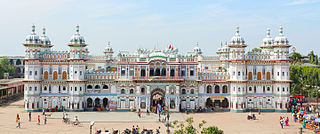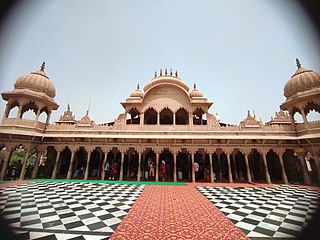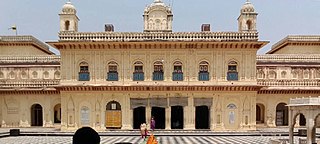
Shatrughna is a prince of Ayodhya, King of Madhupura and Vidisha, and a brother of Prince Rama in the Hindu epic Ramayana. He is also known as Ripudaman. He is the twin of Lakshmana. He is a loyalist of Bharata, just like Lakshmana is to Rama. According to the Valmiki Ramayana, Shatrughna is an incarnation of the Sudarshana Chakra. Shatrughna also appears as the 412th name of Vishnu in the Vishnu Sahasranama of the Mahabharata.

Orchha is a town, near the city of Niwari in the Niwari district of Madhya Pradesh state, India. The town was established by a Bundela rajput ruler Rudra Pratap Singh some time after 1501, as the seat of an eponymous former princely state of covering parts of central & north India, in the Bundelkhand region. Orchha lies on the Betwa River, 80 km from Tikamgarh & 15 km from Jhansi in Uttar Pradesh.

Ramcharitmanas, is an epic poem in the Awadhi language, based on the Ramayana, and composed by the 16th-century Indian bhakti poet Tulsidas. This work is also called, in popular parlance, Tulsi Ramayana, Tulsikrit Ramayana, Tulsidas Ramayana or simply Manas. The word Ramcharitmanas literally means "Lake of the deeds of Rama". It is considered one of the greatest works of Hindu literature. The work has variously been acclaimed as "the living sum of Indian culture", "the tallest tree in the magic garden of medieval Indian poetry", "the greatest book of all devotional literature" and "the best and most trustworthy guide to the popular living faith of the Indian people".

Sita, also known as Siya, Janaki, Maithili, Vaidehi and Bhumija, is a Hindu goddess and the female protagonist of the Hindu epic, Ramayana. She is the consort of Rama, the avatar of the god Vishnu, and is regarded as a form of Vishnu's consort, Lakshmi. She is also the chief goddess of Rama-centric Hindu traditions. Sita is known for her dedication, self-sacrifice, courage, and purity.

Tikamgarh district is one of the 52 districts of Madhya Pradesh state in central India. Tikamgarh town is the district headquarters. The district is part of Sagar Division.

Janaki Mandir is a Hindu temple in Janakpurdham, Nepal, dedicated to the Hindu goddess Sita. It is an example of Koiri Hindu architecture. Fully built in bright white and constructed in an area of 1,480 square metres in the Mithila Kingdom, it is a three-storied structure made entirely of stone and marble.

Janakpurdham or Janakpur is a sub-metropolitan city in Dhanusha district, Madhesh Province, Nepal. The city is a hub for religious and cultural tourism. A headquarter of Dhanusha district, Janakpur is also the capital for Madhesh Province.

Chaturbhuj Temple, dedicated to Vishnu, is situated at Orchha in Madhya Pradesh, India. The name Chaturbhuj is a combination of 'chatur' meaning "four" and 'bhuj' meaning "arms" which literally translates to "one who has four arms" and refers to Rama an Avatar of Vishnu. The temple has a complex multi-storied structural view which is a blend of temple, fort and palatial architectural features.

Mahavir Mandir is a Hindu temple dedicated to the god Hanuman, located in Patna, Bihar, India. Millions of pilgrims visit the temple every year. Acharya Kishore Kunal is the secretary of the Mahavir Mandir Temple Trust, Patna.

ISKCON Vrindavan, also called Sri Sri Krishna Balaram Mandir, is one of the major ISKCON temples in the world. It is a Gaudiya Vaishnava temple located in the city of Vrindavan, Mathura district, in the Indian state of Uttar Pradesh. The temple is dedicated to the Hindu gods Krishna and Balarama. The other deities of temple are Radha Krishna and Gauranga Nityananda.

Vivaha Panchami is a Hindu festival celebrating the wedding of Shri Rama and Devi Sita in the Janakpurdham which was the capital city of Mithila. It is observed on the fifth day of the Shukla paksha or waxing phase of moon in the Agrahayana month as per the Bikram Samvat calendar and in the month of Margashirsha. The day is observed as the Vivaha Utsava of Sita and Rama in temples and sacred places associated with Rama, such as the Mithila region of Nepal and Ayodhya of India. In the Braj region, this day is also celebrated as the manifestation day of Banke Bihari form of Shri Krishna and hence also known as Vihāra Pañchamī.

Orchha State was a kingdom situated in the Bundelkhand region and later a princely state in British India. The state was ruled by Bundela clan of Rajputs. It was located within what is now the state of Madhya Pradesh.

Rama Navami is a Hindu festival that celebrates the birth of Rama, one the most popularly revered deities in Hinduism, also known as the seventh avatar of Vishnu. He is often held as an emblem within Hinduism for being an ideal king and human through his righteousness, good conduct and virtue. The festival falls on the ninth day of the bright half of the lunar cycle of Chaitra (March–April), the first month in the Hindu calendar. It is also part of the Chaitra Navaratri festival in spring. Rama Navami is a holiday for government employees in India.

The Ramchaura Mandir is a Hindu temple in the city of Hajipur, Bihar, India. Dedicated to Lord Rama, it is located at Rambhadra near Helabazar. According to local folklore, it has been in existence since the Ramayana period; Rama is believed to have visited this place on his way to Janakpur, where his footprints are worshiped. The Ramchaura Mandir has a tradition of celebrating Rama Navami, the birth anniversary of Rama, every year. A small fair is also organised on the eve of Rama Navami.

The Orchha Fort complex, which houses a large number of ancient monuments consisting of the fort, palaces, temple, and other edifices, is located in the Orchha town in the Indian state of Madhya Pradesh. The fort and other structures within it were built by the Bundela Rajputs starting from the early 16th century by King Rudra Pratap Singh of the Orchha State and others who followed him.

Siya Ke Ram is an Indian TV series on Star Plus produced by Nikhil Sinha under the banner of Triangle Film Company. This show presents the epic Ramayana, the story of Rama and Devi Sita from Sita's perspective. The show features Madirakshi Mundle and Ashish Sharma playing as Goddess Sita and Lord Rama, respectively, and Karthik Jayaram as Raavan. It premiered on 16 November 2015 and ended on 4 November 2016.

Om Namo Venkatesaya is a 2017 Indian Telugu-language Hindu devotional biographical film directed by K. Raghavendra Rao and produced by A. Mahesh Reddy on AMR Sai Krupa Entertainments banner. The film stars Nagarjuna as Hathiram Bhavaji, alongside Anushka Shetty, Jagapathi Babu, Saurabh Raj Jain, and Pragya Jaiswal. Sai Kumar, Rao Ramesh, Sampath Raj, Ashmita Karnani, Brahmanandam, and Ajay play supporting roles. It has music composed by M. M. Keeravani. The film was dubbed in Tamil as Akhilandakoti Brahmandanayagan. The film failed at the box office.

Kothandaramar Temple is a Hindu temple located in Vaduvur, Tiruvarur district of Tamil Nadu, India, dedicated to Rama, the seventh avatar of the god Vishnu. The temple is glorified by Maharishi Valmiki and classified as one of the 108 Abhimana Kshethrams of the Vaishnavate tradition. This temple is called as the Dakshina Ayodhya(Ayodhya of South India). This temple one of Pancha Rama Kshethrams. All these temples are said to be particular locations mentioned in Ramayana.

Shri Radha Rani Temple, is a historical Hindu temple, located in Barsana in Mathura district, Uttar Pradesh, India. The temple is dedicated to the goddess Radha. The main deities of the temple are Radha Krishna who are worshipped together in the form of Shri Laadli Lal which means beloved daughter and son of the town.

Kanak Bhawan is a temple in Ram Janmabhoomi, Ayodhya, which is in the north-east of Ramkot. It is one of the most famous temples of Ayodhya. It is believed that this palace (temple) was gifted by Kaikeyi, immediately after the marriage of Rama with Sita and hence, it is their personal palace. According to the mythology, after the original Kanak Bhawan was damaged, it was rebuilt by Krishna himself in the Dvapar Yuga. It is believed that it was renovated by Vikramaditya in the medieval period. Later, it was renovated by Queen Vrishabhanu Kunwari which is still present today. The main idols installed in the sanctum sanctorum are of Rama and Sita.






















